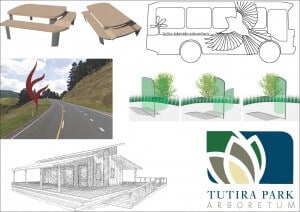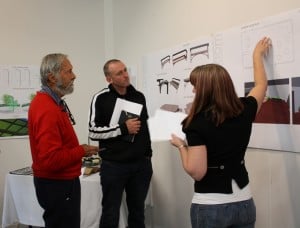EIT design students are fine-tuning branding concepts they have created for the arboretum at Tutira as the trust managing the former farm looks ahead to more fully realising the vision of environmentalist Herbert Guthrie-Smith.
Groups, comprising 22 second-year students in EIT’s Bachelor of Visual Arts and Design programme, recently presented their initial concepts to the Guthrie-Smith Trust. One student, working independently, also delivered a Maori perspective on Tutira and Guthrie-Smith, the former owner who farmed the 90 hectares now under the governance of the trust.
The project-based learning exercise is generating ideas that may be used for the arboretum –whether that’s in the design of its logo, signage, picnic tables, educational material, track map leaflets, car park layout or a building to house a visitor information and education centre.
Trust chairman John Nott said the concept of students designing the branding was “absolutely marvellous” and that the preliminary presentations were well worthwhile.
“The skills, work done and the ideas in the presentations are excellent, and very professional for students. It’s been a very successful exercise – we have got a lot of good ideas out of it from the different groups.”
Triggering the exercise, the trust approached EIT’s School of Arts and Design to explore interest in students designing signs for the arboretum. Lecturers brainstormed the suggestion, and proposed widening the brief to make it a real-world branding assignment.
The four groups of students had little knowledge of what their classmates were doing in the lead-in to the first presentation. Graphics design lecturer Anthony Chiappin said that had resulted in very diverse concepts.
Deputy chairman David Allan said the trust was thrilled with their presentations.
“We have been very impressed to this point. I think we were all optimistic and we were certainly all excited. We remain very optimistic and are now extremely excited.”
With a further, final presentation next month, the students are now exploring additional branding elements and drawing on feedback in refining their group concepts for pitching to the trust.
Trustee suggestions included slowing the pace of presentation delivery, designing maps with graded walking tracks, using sustainable materials for signage and making a landscaping feature of a noticeboard providing information on the area’s history and geology.
The trust is developing the arboretum, north of Napier, as a repository of tree species from all over the world. The present block of land is the remainder of some 20,000 hectares farmed by Guthrie-Smith for many years. The daughter of the committed environmentalist and author, Barbara Absolom, gifted the land to the trust in 1942 as an educational and recreational centre for the people of New Zealand.
EIT, Friends of the Trust and schools have helped with some of the extensive planting on the western slopes above Lake Tutira, a 25-minute drive north of Napier.
The lake and surrounds already provide recreation activities that include an education centre with accommodation and courses on orienteering, rope work, kayaking and other outdoor pursuits. The scenic lakeside is also popular with picnicker and campers.
The trust is planning to open the arboretum more widely to the public, the scientific community and school groups. It also sees considerable potential for promoting the area as a tourist destination.
“The branding collateral for the arboretum could involve the School of Arts and Design for a very long time,” Anthony said. “I can see this have the potential to unfold over the next 20 years.
“It’s a beautiful place and it will become more so as trees planted over the last five or six years gain maturity. The plans for the arboretum are fantastic – it’s about building on the ecology of the area and delivering something special and sustainable to future generations.
“The project-based system of learning happens very rarely in New Zealand. It’s an awesome project for our students to be working on and they are being very competitive, which is good. The dynamic between them is definitely there, and it’s a healthy thing, bringing out the best in them.”


